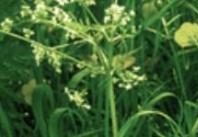ETo, Brutus?
Like Dan said, we had a good billet of jobs this time around.While Dan was putting in the last of the seeds I was finishing up the drip irrigation work.Both orchards and the test field are now set for timed drip irrigation.
The trick was figuring out how much water to give them.
This I figured out before we came out on the field. It is based on local evapotranspiration, which is a cool word guaranteed to clear a room at any hipster gathering. In short, evapotranspiration is the amount of water used by your field in evaporation (from the soil) and transpiration (by the plants). It is measured in inches over a period of time (month, day, etc.). The reference ETo for your area can be obtained through the extension service. For California it can be obtained via the California Irrigation Management Information System (CIMIS) web page at http://wwwcimis.water.ca.gov/cimis/welcome.jsp.
Here is a simplified description of the process, and a chart to follow. I made up the chart based on the CIMIS information. Nothing is easy.
I went to the site and found some sensor stations near our farm and requested the ETo data for the week. This week the rate was averaging at about .15” per day.
I then figured out the square footage my crop was taking up. For a year old dwarf fruit tree, this was about 4 square feet of canopy. A tree with a 4 square foot canopy on a day with a .15 ETo will need .37 gallons of water to replenish what is lost in evapotranspiration. Multiply that by 7 and you get 2.6 gallons a week.
I use 1 gallon per hour (gph) emitter on each tree. Since I water the trees twice a week, I set the timers to go for 78 minutes (1.3 hours) on Wednesday and Saturday mornings at 5:00 am. That gives me 1.3 gallons per watering and 2.6 gallons per week. Viola! Wet trees!
That is the basic stuff. I also need to add other things like precipitation (free water!), the field capacity of my soil (how much water this kind of soil can hold), the efficiency of the sprinkler/drip emitter, root depth, water depth, and a host of other things I’ll cover another day. For example, I was told that a lot of orchard farmers don’t know how far down the water they apply really goes and that its depth can affect tree production and root growth a great deal. We can find that out by using a soil auger to get a sample and pinch out “ribbons” of soil to measure the amount of water in the soil.
Using this method I figured out how much water we are going to need over the year and when. This helped me identify our choke points. For example, based on last year’s EV numbers, we will need around 1,300 gallons of water for our trees and test field in July. Our current water tank holds 200 gallons, so I will be filling it up at most every 5 days. When we add trees and fields this number will go down fast. I also figured that we need about the same amount of water for two and a half trees as we do for a field like our 400 square foot test field at 65% capacity. This will help us make our crop distribution plans: Do we plant more trees or more row crops? How much do we make on each? How much water extraction and storage capacity do we have?
One thing about a 3-hour trip to the farm is the chance to have a long planning meeting. I showed these water numbers to Dan and we came up with the following points:
- If we don’t want to dig another well (and we would like to save that pleasure for someone else) we will be resource constrained before too long. My first estimate is that we will need 6,600 gallons per year (Okay, based on a drought year, but this is California) to run what we have. Our well pump does 5 gallons per minute.
- If we wanted to run our pump 24/7 we could water 4.8 acres of vegetables or 1,010 trees.If we did this, Grundvos would either sue us or put us in a commercial.And what fairy dust will this pump run on?
- Almost everyone who is not doing cattle is doing trees around us. The few vegetable fields are small and covered in plastic mulch. They also get county water.
- Long rows of crops in our environment will be very resource intensive. Planting low-margin vegetables might not make the best business sense. Alternatives include biointensive configurations, value-added products, and greenhouse products. We would still do row crops, but not on a large scale. We could also do more fall and winter crops when water is free.
- We could store water. There is also a creek we could pump from. However, this increases equipment costs.
This is good information and helps us refine our farm plan. If we have learned anything so far, it is that we live in a state of constant refinement.
